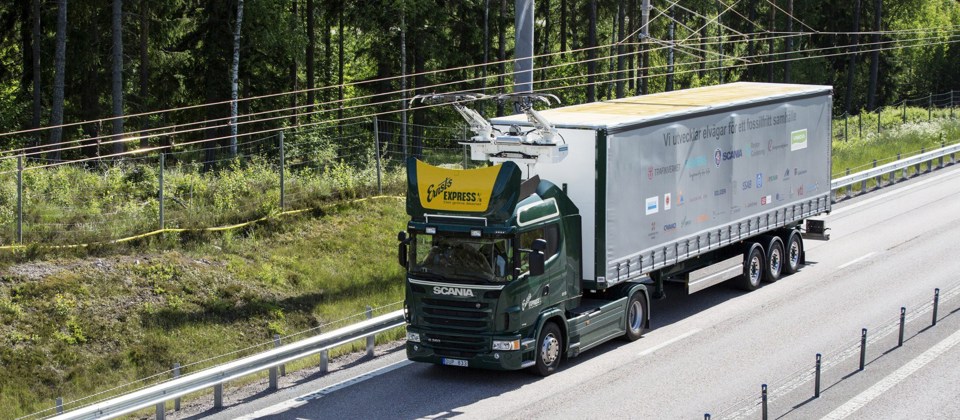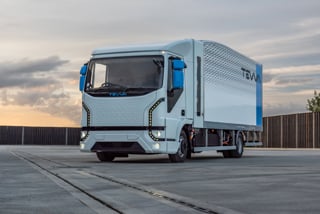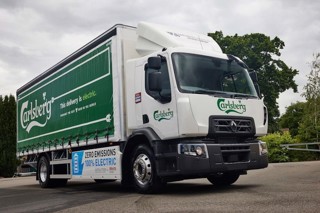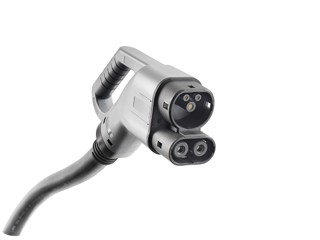An Electric Road System (ERS), where HGVs would charge their vehicle via overhead cables, offers the best solution for electric trucks, according to Centre for Road Freight Sustainability.
David Cebon, director at the Centre for Road Freight Sustainability and professor of mechanical engineering at Cambridge University, told delegates at the recent SCALA Supply Chain Annual Debate that such a system would cost £20 billion.
However, this would significantly reduce both battery sizes and the scale of the charging infrastructure required.
Cebon also reiterated the key fact that hydrogen powered vehicles require three times the amount of electric power generation of electric vehicles.
To power our HGV industry an ERS network would require 10.6 gigawatts of electricity, equivalent to 3,500 wind turbines. In comparison hydrogen vehicles need 35.6 GW, equivalent to 12,000 wind turbines, he said.
Cebon demonstrated that the total cost of ownership of electric vehicles was less than the cost of running vehicles currently, while the opposite applied for hydrogen vehicles which would cost more.
The annual debate revealed an industry eager to learn more about the merits of electric versus hydrogen as the best solution for the long-term future for the HGV transport industry.
Much of the debate focused around whether hydrogen or electric powered HGVs will be the most practical and financially viable option for the logistics industry and UK Government.
Cost was also discussed by William Rowe, founder, and CEO of Octopus Hydrogen, as he explained that one of the main benefits of green hydrogen is that it can be produced free of charge by processing the excess electrons from renewable electricity generation.
Rowe also believed that with further development the total cost of hydrogen vehicle ownership will decrease over time.
His overall conclusion was that hydrogen does have the potential to be a credible alternative for HGVs as the technology continues to advance and the UK increases investment in the industry, but it is likely the future will be a mix of electric and hydrogen.
Justin Laney, fleet manager at the John Lewis Partnership, detailed how the retailer aims to have its fleet free of fossil fuels by 2030 and be net zero by 2035.
Laney partially championed the use of electric as the business plans to ultimately transition to EVs in the future and was concerned at the potential safety challenges of hydrogen.
As Laney stated, there remain significant unknowns to running a green fleet, including the cost of operation. However, on a practical basis he planned to use biofuels including biomethane and biodiesel in the transition period.
Finally, he emphasised the importance of the £200 million of Government funding injected into a three-year zero emission road freight program as he maintains that both ERS networks and hydrogen systems involve significant financial and logistical risk.
Rob Wright, executive director of SCALA, said: “This year’s debate was excellent. Whilst the transport industry has made good progress over recent years in reducing its carbon footprint, the challenge of net zero is a massive step change. So, the debate was a great opportunity for the delegates to hear and understand the arguments and issues directly from a group of experts who all understood the detail and practicalities facing the transport industry.
“Whilst there are many issues to address, the key facts point to an ERS and Electric HGVs as being by far the most efficient way forward for most of the UK. The alternate of hydrogen, battery only or alternative fuels will be needed for the most remote areas.
“Yes, a large investment is needed in the road infrastructure to install ERS but the benefits in the lower power generation required to operate ERS and Electric HGVs are enormous.
“Whatever happens, the UK must be cognisant of what is happening in Europe. We can’t end up with totally different approaches.”
























Login to comment
Comments
No comments have been made yet.